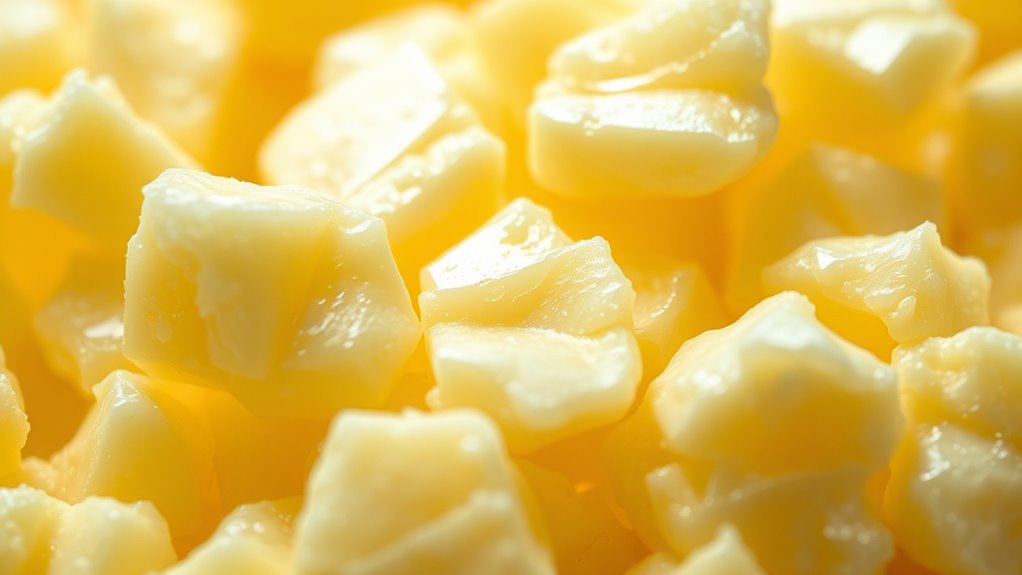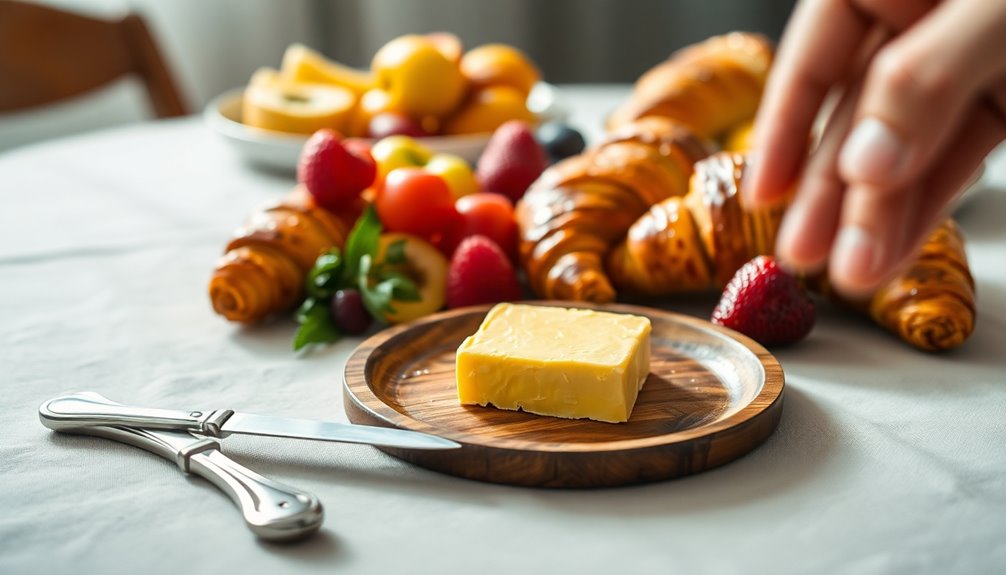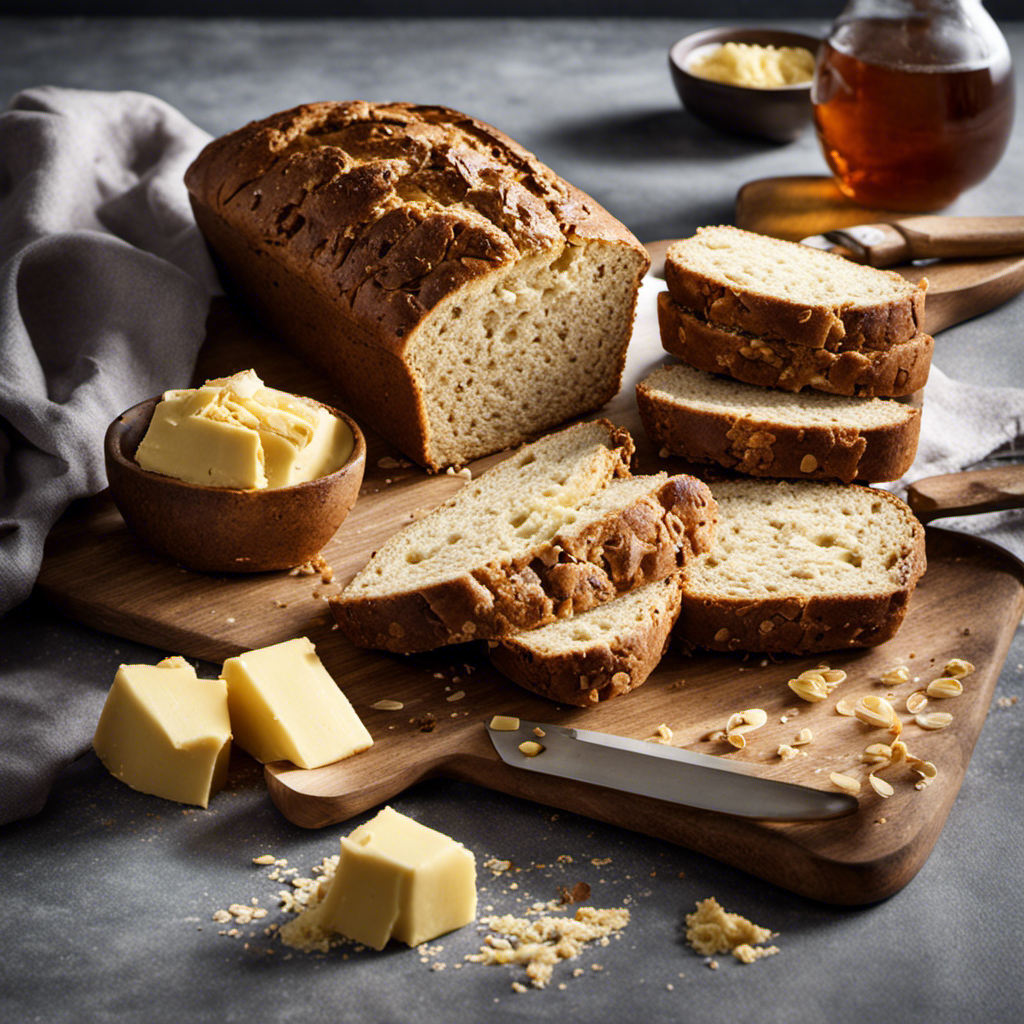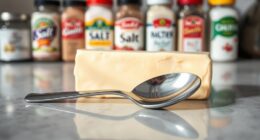Butter’s texture is all about its crystal structure. When fat molecules crystallize properly, you get a creamy, luxurious mouthfeel. If the crystals form unevenly, you might notice graininess or clumpiness, making the butter less spreadable. Factors like temperature and churning time play a big role in this process. So, next time you look at your butter, remember that those tiny crystals are key to its texture. Discover how to optimize your butter experience further!
Key Takeaways
- Crystals formed during churning create butter’s mouthfeel, influencing its creamy texture and spreadability.
- Butter color varies with cow diet and processing, but it does not impact texture or flavor.
- Proper temperature and churning time are crucial for optimal crystal formation, ensuring a luxurious consistency.
- Poor crystallization can lead to undesirable textures like graininess or excessive softness, affecting overall quality.
- To preserve texture, let butter soften slightly before use and handle it with care to maintain crystal integrity.

When you think about butter, you might not immediately consider the role of crystals in its texture, but they’re fundamental to achieving that perfect creamy consistency. The way butter feels when you spread it on warm toast or melt it in a pan is largely influenced by the crystalline structure formed during the churning process. These crystals, made from fat molecules, create a delicate balance that defines butter’s mouthfeel and overall quality.
You might’ve noticed that some butter looks different from others, perhaps with a slight sheen or varying shades of color. This is where butter coloring comes into play. The natural color of butter can vary based on the cow’s diet, but sometimes producers add coloring to standardize it. While this coloring can make butter visually appealing, it’s the crystals that truly impact the texture. Properly formed crystals help preserve that luxurious mouthfeel, allowing the flavor to shine through without feeling greasy or overly thick.
The visual appeal of butter may vary, but it’s the crystal structure that truly defines its luxurious texture.
When you spread butter on bread or use it in cooking, you’re experiencing the results of crystal formation. If the butter’s texture is grainy or too soft, it likely indicates that the crystals haven’t formed correctly. Factors such as temperature during processing and the churning time can affect this. You want to avoid overworking the butter, which can lead to undesirable textures. Instead, a careful approach lets the crystals form nicely, ensuring that your butter maintains its rich, creamy quality.
Texture preservation is vital in butter-making. If you’ve ever encountered butter that’s hard to spread or has a clumpy consistency, it’s often due to improper crystal formation. The right balance of temperature and time allows the fat molecules to align perfectly, creating a smooth texture. When you let your butter soften slightly before using it, you’re giving those crystals a chance to meld, enhancing the buttery experience.
Next time you reach for butter, take a moment to appreciate the science behind its texture. The interplay of crystals, the impact of butter coloring, and the importance of texture preservation all contribute to that delightful spread. By understanding these elements, you can choose the best butter for your culinary needs and elevate your cooking and baking game. Enjoy the creamy goodness that comes from well-formed crystals, and savor the rich flavors they help deliver. Additionally, keep in mind that the proper temperature during processing can significantly influence the quality and texture of the butter.
Frequently Asked Questions
How Do Butter Crystals Affect Flavor in Baking?
Butter crystals can considerably enhance the flavor in your baking. During the crystallization process, the fat molecules create a unique texture that allows for better flavor distribution. When you use butter with smaller crystals, you’ll notice a richer, creamier butter flavor in your treats. This results in baked goods that melt in your mouth and have a more pronounced buttery taste. So, keep an eye on that crystallization for delicious results!
Can I Prevent Butter Crystals From Forming?
You can prevent butter crystals from forming by ensuring proper butter storage. Keep your butter in an airtight container in a cool, dark place or the refrigerator to minimize temperature fluctuations. Avoid exposing it to air or moisture, which can lead to crystallization. When melting butter, do it gently over low heat. This way, you maintain a smooth texture, enhancing your baked goods without those unwanted crystals affecting the overall flavor and consistency.
Are Butter Crystals Safe to Eat?
Absolutely, butter crystals are safe to eat! Think of them as tiny, crunchy gems hidden in your creamy treasure. They form during butter storage due to temperature changes and moisture, but they won’t harm you. While they might alter the texture a bit, they won’t change the flavor. If you prefer a smooth experience, just gently warm the butter and stir. Enjoy your culinary creations without worry!
Do Different Types of Butter Create Different Textures?
Yes, different types of butter can create varying textures. The butter composition, such as fat content and water levels, plays a vital role. For instance, European-style butter typically has a higher fat content, resulting in a creamier texture, perfect for pastries. Additionally, proper storage techniques, like keeping butter in an airtight container, can help maintain its texture, preventing it from absorbing odors or developing unwanted crystals. So, choose your butter wisely for the best results!
How Do Temperature Changes Influence Butter Crystallization?
Temperature fluctuations directly influence butter crystallization by affecting how the fat molecules align and solidify. When you heat butter, the fat melts, disrupting the existing crystal structure. As it cools, you can control the crystallization process by managing the temperature. If you cool it too quickly or unevenly, you’ll end up with a gritty texture. For smooth butter, aim for gradual cooling to ensure even crystallization and a uniform texture.
Conclusion
As you savor that rich, creamy bite, think of butter as a shimmering lake, its surface sparkling with tiny crystals that dance like sunlight on water. Each crystal tells a story of careful crafting, whispering secrets of texture and flavor. Just as a painter selects each brushstroke, the butter’s texture transforms your dish into a masterpiece. So, when you spread it on warm bread, remember: you’re not just enjoying food; you’re relishing a symphony of nature’s artistry.










